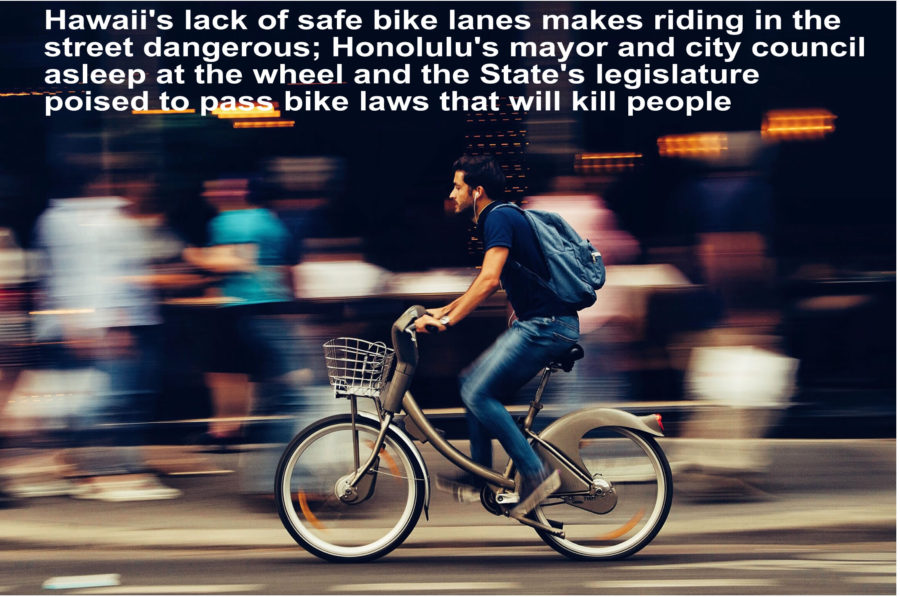Moriwaki's at it again, this time sponsoring SCR68 and SR35 that would, in effect, create a deadly scenario for e-vehicle riders and motorists alike
Moriwaki might just be too out of touch for public service: from the privatization of public lands and assets, to the sponsoring of laws that could severely injure or kill people
SCR68 and SR35 would instantly, should they become law, pose an immediate and extreme danger to the safety and wellbeing of both, electric vehicle riders and motorists alike.
Few viable bike lanes
These pieces of legislation put the cart before the horse. Before we begin forcing bicyclists, skateboarders, scooter riders and the like to commingle in some of the most heavily trafficked roads in the nation, it is time that the legislature, and Honolulu's city council, and its mayor, step up to the plate and begin a process to ensure that our roads have a well-thought-through network of bicycle lanes.
As of this writing, the ONLY serious attempt at providing bicycle lanes for the public, in the entire State of Hawaii, is the one on King Street in Honolulu. This kind of bike lane supports multiple rider vehicles (bike, skateboard, scooter, etc.) and, not surprisingly, is well utilized, making King Street much safer for everyone.
Most of the bike lanes in the State of Hawaii are marginal at best. For example, the bike lane along Ala Wai Blvd., in Honolulu, is nothing more than two additional lines painted onto the road, the width between the lines not wide enough for safe scooter or skateboard traffic and, disturbingly, puts the bike rider at risk of parked car owners opening their doors, suddenly, across the bike lane. This kind of bike lane design, common in Hawaii, is nothing more than irresponsible and should be modified immediately to provide for both the safety of bikes and motorists.
The topic of electric rider vehicles is a slightly more complex subject than the legislature would have us believe
Secondly, there are numerous problems with lumping electric rider vehicles into one category. Let's look at electric bicycles for a moment.
There are pedal assist e-bikes that can be operated as either an electric vehicle or a standard manual bicycle, with derailleur gears and all of the features found on a manual bike. These are very popular in a variety of sizes and are factory set to not exceed 20mph in electric mode, about the same speed as a non-electric bike. These bikes do NOT pose any more threat to pedestrians than a regular bicycle. If a person is riding one of these dual-purpose bikes, in manual mode, on one of our sidewalks (probably because it was too dangerous to operate the bike in Honolulu traffic on a road with no bike lane or one with one of our more traditional substandard bike lanes), how do you enforce this? Do you tell this person to leave the relative safety of the sidewalk for the very real danger of riding on one of our streets?
Other kinds of electric bikes: non-pedal-assist-throttle-only: these kinds of e-bikes come in a variety of designs and manufacture. Some are homemade and can exceed 50mph; most, however, are factory made and cannot exceed 20mph. And then there are e-bikes that are being used for commercial purposes; right now, for things like delivery services.
The discussion of how to regulate e-bikes alone is complex. Most e-bikes are little different from good quality manual bikes; some are more like motor scooters.
And then the whole conundrum of other types of e-assisted rider vehicles. There are at least three different categories of electric skateboards, for example, each with its own set of characteristics regarding degree of maneuverability and rider safety. Electric "scooter" is a generic term, as there are several different types of what we might call "scooters;" each one with its own handling and rider safety characteristics.
Why are bicyclists riding on sidewalks?
A scooter is not a bicycle is not a skateboard. Should these riders be riding on city sidewalks? Probably not. Then, why are they doing this? Simple. The roads in Hawaii are remarkably dangerous for bike riders, let alone riders of scooters and skateboards.
Expensive legal challenges a no-brainer
Frankly, in addition to the immediate risk of severe injury or death, SCR68 and SR35, by forcing riders into the street, put the State of Hawaii, and the City of Honolulu at risk for major legal challenges that may end up costing taxpayers $millions of dollars (that could have been spent on decent bike lanes to begin with).
Don't put the cart before the horse: Hawaii needs an intelligent network of bike lanes before it starts forcing riders into some of the most dangerous traffic in the country
We would ask the legislature, at this point, to please do the right thing: put this legislation aside until such time as you've addressed the more urgent question of responsible implementation of safe bike lanes throughout the City of Honolulu and the State of Hawaii.

